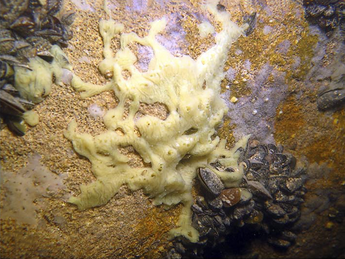
Halichondria bowerbankii (Bowerbank's Halichondria; Crumb of Bread Sponge; Yellow Sun Sponge) typically occurs is bays and harbors, while a similar species, H. panicea (Crumb of Bread Sponge) usually occurs on open coasts. Bowerbank's Halichondria usually starts growing as a thin crust, but develops into lobes. fingers, or branches. Colonies vary from 50-75 mm tall, with colonies up to 150 mm wide. The similar H. panicea is widespread in the Northern Hemisphere. Halichondria bowerbankii is usually considered native to both sides of the North Atlantic, from Iceland and Norway to the Mediterranean and the Azores, and Maine to Florida. It has been introduced to the West Coast, from San Diego to British Columbia. It was first found in San Francisco Bay in the 1950s, and was probably introduced with Eastern Oysters, or hull fouling. This sponge occurs on rocks, pilings and seaweeds. It ranges from full seawater to the upper mesohaline zone (15-18 PSU). It now ranges from San Diego to Prince Rupert, British Columbia. It has also been found on the north, east, and south coasts of South Korea. It has probably been introduced to the West Coast with Eastern Oysters, or with hull-fouling.